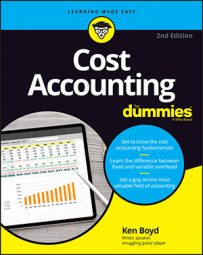When cost accounting, if you think investigating a variance is tough, try ignoring one sometime. Yes, following up takes time and may involve phone calls, discussions with your staff, or additional research into supplier relationships. But if the variance is relevant, you gotta do it.
In accounting, you see the term relevance used frequently. Relevance refers to something that’s worth noticing. You need to decide what variances are important to you. Here’s some simple advice: If a variance amounts to a big percentage difference between actual results and plan, or if it amounts to a big out-of-pocket cash difference, you should investigate.
Don’t waffle on the impact of defective products in cost accounting
If you produce defective products, you’re spending production costs on goods that cannot be sold to customers. You may be able to repair the product and sell it, but that will require more costs, too. So defective products result in unfavorable cost variances. You spend more than you planned.
You also may see a decline in sales, as unhappy customers stop buying your product. The sales decline means an unfavorable sales variance. You sell less than you planned.
A defective product will kill you ten ways to Sunday. Any defect in any product qualifies. The impact won’t be good. The first thing you don’t need is diminished sales, and the last thing you need is dozens of bad comments on a consumer website.
This isn’t just a matter of a cost accounting variance. A defective product is the core of ruined image, publicly aired complaints, and a general undermining of confidence in your entire product line.
Simple advice is for you to look at the defect, find the cause, correct the cause, and make things right with your customer base. And for that matter, take what steps are necessary to reduce the chances of producing defective products in the future. The time investment is worth the effort.
You don’t have to spend a lot of time on the Internet to find stories about companies that were seriously damaged by making defective products and failed to handle the problem.
Pick a guideline for variances in cost accounting
For variances other than serious product defects, pick a dollar amount or percentage as a big red flare. That is, choose a guideline for investigating variances.
Say you’re making watches. It doesn’t matter whether you put out costly Rolex watches at $15,325 or inexpensive Casio watches at $6.95. Each line suggests a guideline for concern.
You might decide that a variance of 10 percent or more from your standard amount is an issue. If your standard direct materials cost (cost x quantity) is $50,000, a variance, either favorable or unfavorable, of $5,000 or more ($50,000 x 10%) should be reviewed. The same is true if your standard direct material cost is $5,000,000. It’s still 10 percent or more.
Big-ticket items can absorb a variance better than small-ticket items. An affluent customer base is likely to accept price increases, which overcomes variances. The economic law is that consumers buy more of a good when its price is lower and less when its price is higher; however, that law doesn’t seem to apply to luxury items.
Keep in mind that the standards you create in planning (costs, quantities, and so forth) are only an estimate. You can expect some difference between standard and actual amounts. You don’t have a crystal ball to get the standards exactly right. Finally, your company should include the guidelines for variance investigation in your written accounting procedures. That way, everyone in your organization knows the ground rules for variances.
Continuous improvement and benchmarking in cost accounting
Continuous improvement is the process of continually improving your efficiency and thereby reducing costs over time. By reducing costs a small amount each year, you increase your profit over time. You can find areas to reduce costs by investigating variances.
Over time, it may be more difficult to find cost reductions. As with many things in life, you try to do the easy fixes first; you make those changes that are obvious. As time goes on, the changes make your production more efficient. Finding new changes gets harder, but great companies stay at it. They make the effort to find more ways to reduce costs without sacrificing product quality.
If you want to compete, it’s a good idea to compare your performance to other companies in your industry. Benchmarking is the process of comparing your company’s performance to that of similar companies. That performance could mean many things: how quickly you deliver a service or how well you produce a product that minimizes defects. If you do competitive benchmarking, you’re in good company. Some of the largest corporations in the world have such programs.
The purpose of benchmarking is to suggest areas where you can make improvements. If, for example, you can produce and deliver a product faster or reduce costs without affecting product quality, your company can be more profitable.
What you measure relates to what you do. If you’re in a service industry, you might benchmark how quickly you do things: how long a customer waits in line at your store or how quickly can you make a home delivery.
If you manufacture products, you might benchmark product quality. Quality might mean tracking the number of product defects or the percentage of sales that are returned by customers.

